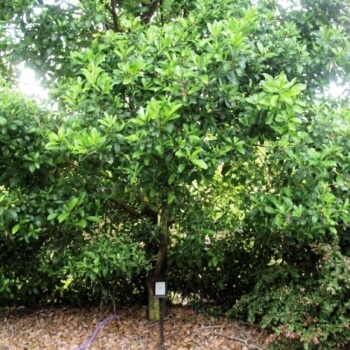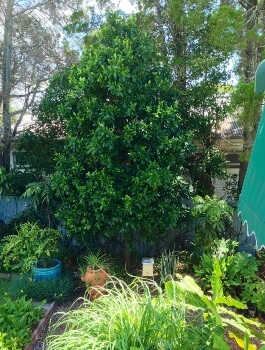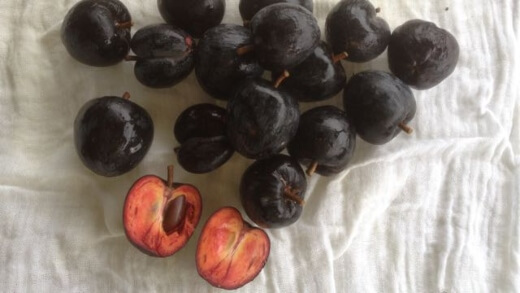The bountiful black apple tree is one of our treasured Australian natives that produces some of the largest fruits of all local bush tuckers, making it a must-have addition for Australian bushfood enthusiasts.
This evergreen rainforest tree features glossy dark-green foliage, a gracefully tall fluted trunk, and of course, its notorious black-skinned plum-like fruits.
Being an easy-to-grow tree that adapts readily to cultivation within gardens, it is a fantastic pick for anyone looking for a medium to a tall tropical tree in their landscapes with some fruiting capability.
In this article, I will be sharing everything you need to know to grow and care for this beloved bush tucker.
More...
Family: | Sapotaceae |
|---|---|
Genus: | Pouteria |
Species: | P. australis |
Origin: | Native to Queensland and New South Wales |
Common Names: | Black apple, yellow buttonwood, yellow bulletwood |
Location: | Outdoor |
Type: | Fruiting tree |
Growth: | 10 to 15 metres tall, 5 to 8 metres wide |
Sun requirements: | Full sun to partial shade |
Foliage Colour: | Green |
Flower Colour: | White (insignificant) |
Flowering: | Spring |
Fruit: | Produces edible plum-like fruits in summer |
Maintenance level: | Low |
Poisonous for pets: | Slightly toxic to cats and dogs |
Introducing the Black Apple Tree
Apart from its already impressive characteristics, the black apple tree can also provide gardens with wonderful silhouetted patches of shade thanks to its dense and beautifully rounded canopy.
Though insignificant, this species does produce small clusters of delicate white blooms in spring that form on branch tips. Take advantage of all the wonderful qualities our native rainforest trees can offer with this remarkable species.
Pouteria australis Plant Details
Forming a part of the Sapotaceae family of plants, this tree is scientifically labelled Pouteria australis (syn. Planchonella australis). Common names include the Australian black apple tree and the yellow buttonwood.
This species is native to the rainforests of Queensland and New South Wales where it naturally thrives in subtropical climate zones. Nowadays, it has successfully adapted to our endemic conditions where it can be grown in many climates from tropical to temperate.
This medium to large tree is fast growing, reaching around 10 to 15 metres tall and 5 to 8 metres wide when established in residential gardens. In the wild, it can grow far bigger.
Apart from the famed fruits, this tree was also prized by colonists as one of the best carving woods in Australia. Helpful plant facts:
- This tree fruits from years 3 to 5 onwards.
- It will attract birds, bees and other beneficial insects.
- Fruits are particularly favoured by the green catbird.
- This species is self-pollinating.
This tree is commonly used as a feature in larger gardens, it can be used to create shady outdoor spaces and can also be grown successfully in pots and containers. Alternatively, it is commonly established for the harvesting of its edible fruits.
How to Grow the Black Apple Tree
You can use seeds or cuttings to reliably propagate this tree. Alternatively, you can purchase a young and healthy tubestock plant from a reputable nursery and transplant it into your garden which is an easier and faster way to grow your own tree.
How to Propagate Black Apple Tree

Source: Fruitipedia


Get Your Free Guide:
Master Growing Australian Natives eBook
A Must Have Complete Guide for Every Australian Garden
Get Your Free Guide:
Master Growing Australian Natives eBook
A Must Have Complete Guide for Every Australian Garden
Propagating Black Apple Tree from Seeds
- Seeds can be collected from ripened fruits or purchased online or in-store.
- Lightly stratify the seeds by sandpapering them at one end until the woody cases are paper thin.
- Sow the seeds fresh in prepared containers filled with a quality seed-raising mix.
- Lightly water them in after sowing then place them in a warm, sheltered location with some bright but indirect light.
- Keep the propagation mix moist as the seedlings develop.
- Germination should occur within 3 to 4 weeks in good conditions.
Propagating Pouteria australis Using Cuttings
- Using a sharpened pruning saw, take a healthy branch cutting of about 10 cm to 15 cm in length from the current season's growth.
- This plant does bleed a milky latex sap when cut or broken so a good pair of gardening gloves is advisable.
- Remove some of the lower leaves from the cutting then dip the cut end into some rooting hormone.
- Prepare a growing container filled with quality potting soil and lightly mix some compost in as well.
- Plant the cutting into the mix to a depth where it is firmly sitting in the container.
- Water lightly after planting then place in a warm, sheltered location with bright, indirect light.
- Allow the cutting to develop for at least 6 months before attempting to transplant it.
Planting Conditions for Black Apple
This tree is best planted in late summer around March. When selecting your planting site, be sure to consider that the tree will need enough space to grow so be sure not to plant it too close to any buildings, paving or other tall vegetation.
Ideal Soil Conditions
Good soil moisture and good drainage will ensure this rainforest tree thrives. It is suitable for light soils like sandy soil, medium soils like loamy soil and even heavy soils like clay. For heavier soils, it is recommended to boost the breathability by mixing in some well-rotted organic matter and compost. Aerate as needed.
Preferred soil pH levels are around neutral between 6.6 and 7.3. Use a soil pH meter to test your soil if you are concerned.
Sunlight Needs
Black apple trees can be planted in full sun to partial shade. Overall, the planting site should be warm and sunny for the most part. Young trees will need some protection from the harsh afternoon summer sun.
Growing Black Apple in Pots
This tree can be successfully grown in larger containers (30 to 50 litre). It will need adequate pruning to maintain a smaller size and keep its shapeliness. It will also require repotting every 3 to 5 years or so. When repotting, use a container one or two sizes bigger each time.
Use a premium potting mix or rich garden soil for your pots. Add mulch or grass clippings around the tree to help retain adequate soil moisture. Container-grown trees will usually only reach about 2 metres tall but should still produce fruit. Water every 1 to 2 days continually.
Caring for Pouteria australis
Once established after about 2 years, this species is tolerant of moderate frosts down to about -5°C. Here is how you can look after your tree and ensure it thrives.

Source: Jerry Coleby-Williams
Watering Needs
In the first two years after planting your tree, it will need to be watered regularly while the roots develop to find their own water. Thereafter, continuously observe the tree and water as needed. On average, water deeply about once or twice a week depending on rainfall.
What Fertiliser to Use
This tree responds well to regular fertilising during its active months between spring and summer. Feed with a balanced general-purpose garden fertiliser or an organic native plant food once every 3 to 4 weeks during the active period.
After the initial planting, delay fertilisation for about a month to avoid burning the roots.
Pruning Black Apple
Pruning your tree will encourage new growth and help maintain a bushy growth habit. Prune at the end of summer by cutting away the tips of the tree branches by about 2 cm to 3 cm. Apart from that, prune as needed to maintain your desired shape and be sure to remove any dead or dying branches.
Mulching
Add a healthy layer of organic mulch like pine bark or grass clippings around the base of your tree in summer to help maintain good moisture levels.
Clean-Up
At the end of summer, you may need to clean up fallen fruits from the ground around your tree. If you leave the fruits to decompose, they may attract unwanted pests to your garden.
Black Apple Pests and Diseases
There is very limited information available that suggests this species suffers from any serious pest or disease issues. The fruits will attract pests like maggots and fruit flies. These pests can be dealt with and they rarely cause any serious damage to the actual plant.
Check out our in-depth guide to fruit fly prevention and treatment for Australian gardens for more info.
Black Apple Tree Bush Tucker Guide
In summer, this tree species produces edible globose fruits that are typically 20 mm to 65 mm long. The fruits are purplish-black in colour and contain 2 to 5 brown shiny seeds. These fruits are some of the largest of all our local bush tuckers.
The large fruits resemble apples or plums in both their size and semblance, hence the plant's common name. Traditionally, these plum-like fruits are called Jerra-wa-wah.
Black apples are most commonly consumed raw out-of-hand where the flesh features a sweetly tart and delicately aromatic flavour with a fibrous texture. Both the purplish-black skin and the fibrous white flesh are edible. The flesh may contain tinges of orange and red.
The black apple tree is packed with health benefits.
Nutritional Value
- Contains higher levels of antioxidants than other varieties of apples.
- These antioxidants can help protect your body from free radicals and reduce inflammation.
- Black apples contain essential nutrients like sodium, potassium, dietary sugars, calcium and iron.
- The fruits are rich in both vitamins A and C.
- They contain only 110 kcal per 100g, 27g of which comes from total carb content.
- They are overall a great source of dietary fibre, vitamins, minerals and antioxidants.
- They are a great low-calorie snack with very little fat, perfect for those looking to lose weight.
- Fruits are also a good source of essential fatty acids that are important for cardiovascular health.
Harvesting Black Apple Fruits
The fruits ripen in summer between September and November. They become darker in colour as they ripen, turning shiny and purplish-blue to black when ready. Once the fruits have darkened in colour and slightly softened to the touch, simply pick them straight from the tree.

How to Use Black Apples
Black apple fruits are most commonly enjoyed raw and fresh after being rinsed as a tasty snack. Alternatively, they make for excellent fruit-based additions to pies and cobblers. You can also cut the fruits fresh and add them to fruit salads for lovely tart pops of flavour.
The fruits can be dried and later used for juices, vinegar and ciders. Lastly, many enjoy making jams from the black apples. Jams display a deep and rich colour with flavours to match.
How to Store Black Apples
The best way to store ripe fruits and keep them fresh is in cold storage. The flesh may become a little juicier and softer when refrigerated. Fruits will not ripen further. Refrigerated fruit will only keep for a few weeks whereas frozen fruits can keep for up to 12 months.
Precautions
- Fruits are favoured by maggots and fruit flies. Be sure to always inspect the fruits before eating them to make sure they are pest free.
- Delay harvests for a few days after fertilising and try to avoid using any pesticides unless absolutely necessary.
- As with any bushfood, be sure to moderate intake and consult a health professional should you be concerned about any pre-existing conditions that may be aggravated by these fruits.
Black Apple Frequently Asked Questions
Why are the leaves of my black apple tree turning brown?
Young trees are particularly prone to leaf burn in very hot and dry weather, especially when planted in full sun positions. Over-fertilising can also lead to burned foliage.
What can I do to prevent maggots from attacking my black apple fruit?
Unfortunately, as these fruits ripen with fleshy and soft skin, maggots and fruit flies are attracted to them. The best way to combat these pesky pests is to individually wrap the fruits as they grow and set traps around your tree to catch mature insects. Be sure to also continuously inspect the tree for fruit fly larvae.
Why is my black apple not producing fruits and flowers?
Poor lighting conditions are typically a common cause when fruiting trees struggle to produce fruits and flowers. Your tree may not be getting enough sunlight in its current position. Try moving it to a sunnier spot or remove any objects creating shade around the tree to allow more light to reach through.
Alternatively, your tree may not be mature enough to produce fruits yet. They take about 3 to 5 years to reach fruiting age.
Can I eat black apples?
Yes, Australian black apples are considered notoriously tasty bushfood. The plum-like fruits can be eaten fresh or used in pies and cobblers.
What does Pouteria australis taste like?
The fruits sport a lovely sweet and tart flavour profile with aromatic notes.
Are black apples healthy?
Australian black apples are a great source of essential vitamins, minerals, antioxidants and dietary fibre. They are also a great low-calorie snack for those interested in losing weight.
For more native trees, be sure to also see our growing guides on:
Boost Your Gardens Fruiting Potential with the Bountiful Black Apple Tree
I hope I’ve managed to convey just how spectacular the Australian black apple tree is. With its large nutritious fruits, charming fluted trunk, glossy green foliage and exquisite round and dense canopy, there’s really a lot to love about this native bush tucker.
Certainly, a must-have for bushfood enthusiasts that have the space to establish a medium to tall tree.
Whether for its fruits or simply for its ornamental influence in landscapes, the black apple tree can boost the vigour of your outdoor spaces while elevating the fruiting potential of almost any Australian garden.
Published on April 21, 2023 by Gary Clarke
Last Updated on January 19, 2025





